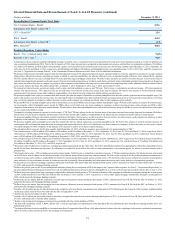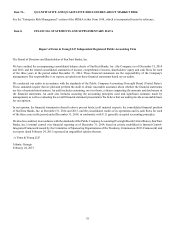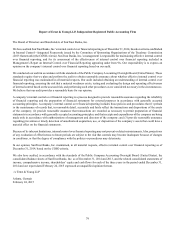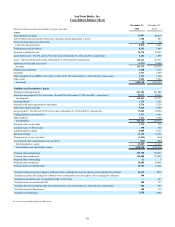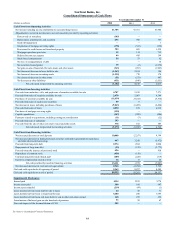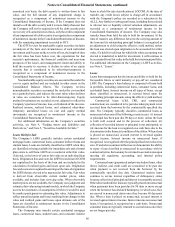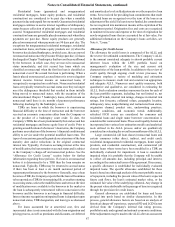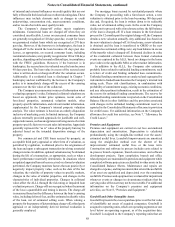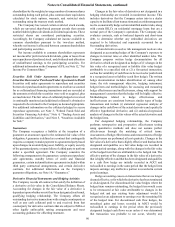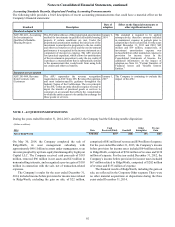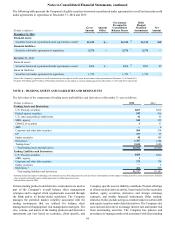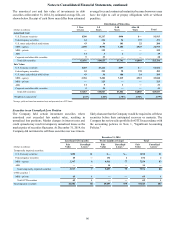SunTrust 2014 Annual Report Download - page 110
Download and view the complete annual report
Please find page 110 of the 2014 SunTrust annual report below. You can navigate through the pages in the report by either clicking on the pages listed below, or by using the keyword search tool below to find specific information within the annual report.Notes to Consolidated Financial Statements, continued
87
Residential loans (guaranteed and nonguaranteed
residential mortgages, home equity products, and residential
construction) are considered to be past due when a monthly
payment is due and unpaid for one month. Guaranteed residential
mortgages continue to accrue interest regardless of delinquency
status because collection of principal and interest is reasonably
assured. Nonguaranteed residential mortgages and residential
construction loans are generally placed on nonaccrual when three
payments are past due. Home equity products are generally
placed on nonaccrual when payments are 90 days past due. The
exceptions for nonguaranteed residential mortgages, residential
construction loans, and home equity products are: (i) when the
borrower has declared bankruptcy, in which case, they are moved
to nonaccrual status once they become 60 days past due; (ii) loans
discharged in Chapter 7 bankruptcy that have not been reaffirmed
by the borrower, in which case, they are moved to nonaccrual
status immediately; and (iii) second lien loans which are
classified as nonaccrual when the first lien loan is classified as
nonaccrual even if the second lien loan is performing. When a
loan is placed on nonaccrual, accrued interest is reversed against
interest income. Interest income on nonaccrual loans, if
recognized, is recognized on a cash basis. Nonaccrual residential
loans are typically returned to accrual status once they no longer
meet the delinquency threshold that resulted in them initially
being moved to nonaccrual status, with the exception of the
aforementioned Chapter 7 bankruptcy loans, which remain on
nonaccrual until there is six months of payment performance
following discharge by the bankruptcy court.
TDRs are loans in which the borrower is experiencing
financial difficulty at the time of restructure and the borrower
received an economic concession either from the Company or
as the product of a bankruptcy court order. To date, the
Company’s TDRs have been predominantly first and second lien
residential mortgages and home equity lines of credit. Prior to
granting a modification of a borrower’s loan terms, the Company
performs an evaluation of the borrower’s financial condition and
ability to service under the potential modified loan terms. The
types of concessions generally granted are extensions of the loan
maturity date and/or reductions in the original contractual
interest rate. Typically, if a loan is accruing interest at the time
of modification, the loan remains on accrual status and is subject
to the Company’s charge-off and nonaccrual policies. See the
“Allowance for Credit Losses” section below for further
information regarding these policies. If a loan is on nonaccrual
before it is determined to be a TDR then the loan remains on
nonaccrual. Typically, TDRs may be returned to accrual status
if there has been at least a six month sustained period of
repayment performance by the borrower. Generally, once a loan
becomes a TDR, the Company expects that the loan will continue
to be reported as a TDR for its remaining life, even after returning
to accruing status, unless the modified rates and terms at the time
of modification were available to the borrower in the market or
the loan is subsequently restructured with no concession to the
borrower and the borrower is no longer in financial difficulty.
Interest income recognition on impaired loans is dependent upon
nonaccrual status, TDR designation, and loan type as discussed
above.
For loans accounted for at amortized cost, fees and
incremental direct costs associated with the loan origination and
pricing process, as well as premiums and discounts, are deferred
and amortized as level yield adjustments over the respective loan
terms. Fees received for providing loan commitments that result
in funded loans are recognized over the term of the loan as an
adjustment of the yield. If a loan is never funded, the commitment
fee is recognized into noninterest income at the expiration of the
commitment period. Origination fees and costs are recognized
in noninterest income and expense at the time of origination for
newly-originated loans that are accounted for at fair value. For
additional information on the Company's loans activities, see
Note 6, “Loans.”
Allowance for Credit Losses
The allowance for credit losses is composed of the ALLL and
the reserve for unfunded commitments. The Company’s ALLL
is the amount considered adequate to absorb probable current
inherent losses within the LHFI portfolio based on
management’s evaluation of the size and current risk
characteristics of the loan portfolio. In addition to the review of
credit quality through ongoing credit review processes, the
Company employs a variety of modeling and estimation
techniques to measure credit risk and construct an appropriate
and adequate ALLL. Numerous asset quality measures, both
quantitative and qualitative, are considered in estimating the
ALLL. Such evaluation considers numerous factors for each of
the loan portfolio segments, including, but not limited to, net
charge-off trends, internal risk ratings, changes in internal risk
ratings, loss forecasts, collateral values, geographic location,
delinquency rates, nonperforming and restructured loan status,
origination channel, product mix, underwriting practices,
industry conditions, and economic trends. Additionally,
refreshed FICO scores are considered for consumer and
residential loans and single name borrower concentration is
considered for commercial loans. These credit quality factors are
incorporated into various loss estimation models and analytical
tools utilized in the ALLL process and/or are qualitatively
considered in evaluating the overall reasonableness of the ALLL.
Large commercial (all loan classes) nonaccrual loans and
certain consumer (other direct, indirect, and credit card),
residential (nonguaranteed residential mortgages, home equity
products, and residential construction), and commercial (all
classes) loans whose terms have been modified in a TDR are
individually evaluated for impairment. A loan is considered
impaired when it is probable that the Company will be unable
to collect all amounts due, including principal and interest,
according to the contractual terms of the agreement. If necessary,
a specific allowance is established for individually evaluated
impaired loans. The specific allowance established for these
loans is based on a thorough analysis of the most probable source
of repayment, including the present value of the loan’s expected
future cash flows, the loan’s estimated market value, or the
estimated fair value of the underlying collateral. Any change in
the present value attributable to the passage of time is recognized
through the provision for credit losses.
General allowances are established for loans and leases
grouped into pools based on similar characteristics. In this
process, general allowance factors are based on an analysis of
historical charge-off experience, expected PD and LGD factors
derived from the Company's internal risk rating process,
portfolio trends, and regional and national economic conditions.
Other adjustments may be made to the ALLL after an assessment


